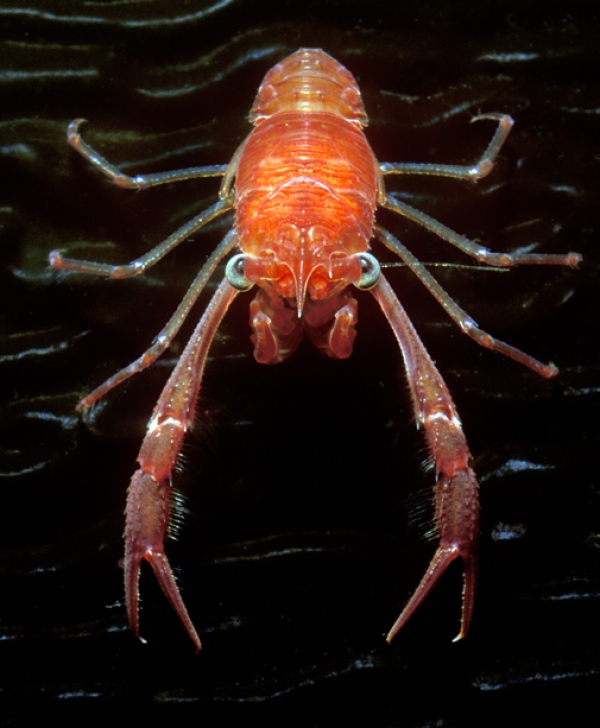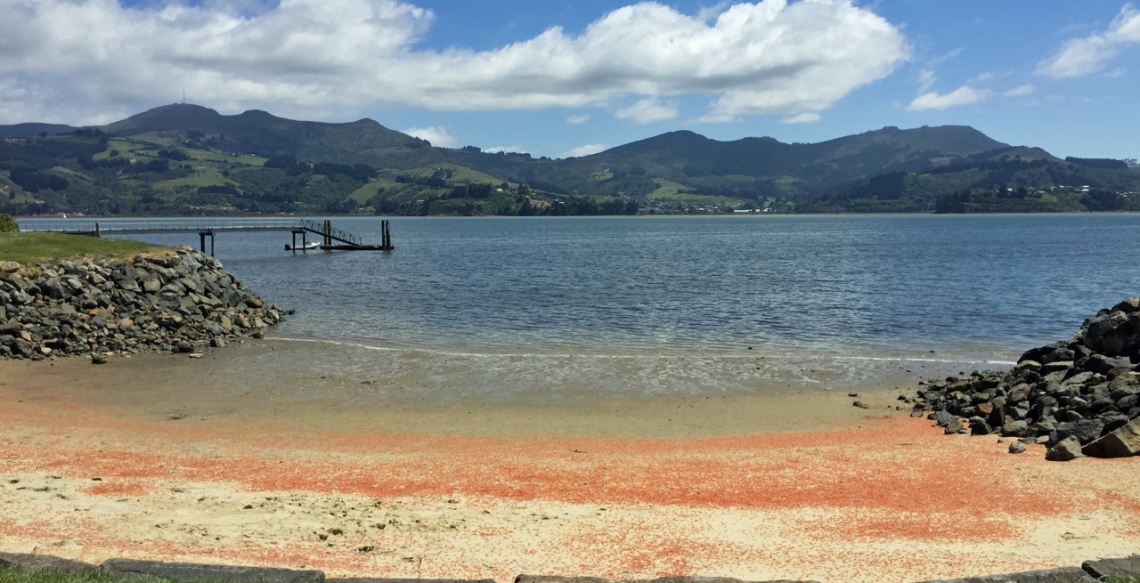What is the difference between our previously featured squat lobsters and this week’s critter?
This one you can actually swim with if you wanted! All the others live at the dark depths of the New Zealand ocean, but Munida gregaria (Fabricius, 1793) or the gregarious squat lobster is commonly found in shallow coastal waters along the eastern coast of New Zealand’s South Island.
It has been referred to as ‘red whale feed’, ‘lobster krill’ and ‘langostilla’ and it is only one of a very few species of squat lobster that produce large swarms during their life cycle.
Painting the beaches red
After they have completed their larval cycle in the open ocean, they metamorphose to a migrating ‘postlarval’ stage which swims inshore to find suitable habitat to settle on. In New Zealand, these postlarvae are usually encountered in the summer months, typically between October to April or May. While abundances vary greatly from year to year, they often form such dense swarms that they turn the water and the beaches red.
See John Zeldis’ 1985 paper on the ecology and considerations for fisheries.
Trans Pacific partnership
Munida gregaria is widely distributed around the southern oceans which is unique for this group of crustaceans. The species was originally described from Patagonia by Fabricius in 1793 and it has attracted attention from many explorers and naturalists over time: e.g., William Dampier (1651–1715), pirate, explorer and natural historian, wrote in A New Voyage round the World (1697): “SMALL RED LOBSTERS The day that we made these islands [the Falklands] we saw great shoals of small lobsters which coloured the sea in red spots for a mile in compass, and we drew some of them out of the sea in our water-buckets… I never saw any of this sort of fish naturally red but here; for ours on the English coast, which are black naturally, are not red till they are boiled”.
Sir Joseph Banks, botanist and Captain James Cook’s companion on HMS Endeavour, also described small shoals near Cape Horn in 1769 in his journal of that voyage. See a page of his illustrations of the species.
Since then it has been reported from the Strait of Magellan, Chile, New Zealand and Subantarctic islands, and Tasmania. In its distribution it appears to defy a well-recognised biogeographic barrier for marine species, the ‘East Pacific Barrier’, thousands of kilometres of uninhabitable deep ocean from one side to the other that typically prevents dispersal. However, a recent study on the genetic connectivity between populations from New Zealand and the southern tip of South America indeed indicate that they are one species, not two separate species that are similar morphologically (see the paper by Pérez-Barros et al).
Lobster à la carte
Squat lobsters in general and Munida gregaria in particular play an important role in the food webs. Munida gregaria is a bottom-feeder, feeding on the detritus, scavenging and occasionally an active predator. In turn, they have been found to be predated on by a long list of species including commercially important fish species, squid, octopus, king crabs, bird and very likely whales. In this they provide a crucial link between the particulate organic matter on the seafloor and the top predators.
See a 2007 study by Vinuesa and Varisco off southern Argentina, which found M. gregaria in the diet of 32 fish species.
A 2007 study completed by NIWA indicated squat lobsters as important food sources for a number of New Zealand fish as well (see the NIWA Water and Atmosphere article "The ups and downs of rock lobster larvae").
Further information
- Sciblog post by Rebecca McLeod with a lovely close-up photo of Munida gregaria at the New Zealand Marine Studies Centre in Dunedin: http://sciblogs.co.nz/science-life/2010/01/18/otago-harbour-in-a-red-frenzy/
- Here is a link to a short video of the Krill Chaos in Otago Harbour, and the langostilla swarming off the Isla Natividad off the Baja peninsula.



